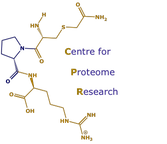The F factor! F for 'flyability'!
Jarnuczak AF, Lee DC, Lawless C, Holman SW, Eyers CE, Hubbard SJ. (2016) Analysis of Intrinsic Peptide Detectability via Integrated Label-Free and SRM-Based Absolute Quantitative Proteomics. J Proteome Res. 2016 (in press)
Quantitative mass spectrometry-based proteomics of complex biological samples remains challenging in part due to the variability and charge competition arising during electrospray ionization (ESI) of peptides and the subsequent transfer and detection of ions. These issues preclude direct quantification from signal intensity alone in the absence of a standard. A deeper understanding of the governing principles of peptide ionization and exploitation of the inherent ionization and detection parameters of individual peptides is thus of great value. Here, using the yeast proteome as a model system, we establish the concept of peptide F-factor as a measure of detectability, closely related to ionization efficiency. F-factor is calculated by normalizing peptide precursor ion intensity by absolute abundance of the parent protein. We investigated F-factor characteristics in different shotgun proteomics experiments, including across multiple ESI-based LC-MS platforms. We show that F-factors mirror previously observed physicochemical predictors as peptide detectability but demonstrate a nonlinear relationship between hydrophobicity and peptide detectability. Similarly, we use F-factors to show how peptide ion coelution adversely affects detectability and ionization. We suggest that F-factors have great utility for understanding peptide detectability and gas-phase ion chemistry in complex peptide mixtures, selection of surrogate peptides in targeted MS studies, and for calibration of peptide ion signal in label-free workflows. Data are available via ProteomeXchange with identifier PXD003472.
Quantitative mass spectrometry-based proteomics of complex biological samples remains challenging in part due to the variability and charge competition arising during electrospray ionization (ESI) of peptides and the subsequent transfer and detection of ions. These issues preclude direct quantification from signal intensity alone in the absence of a standard. A deeper understanding of the governing principles of peptide ionization and exploitation of the inherent ionization and detection parameters of individual peptides is thus of great value. Here, using the yeast proteome as a model system, we establish the concept of peptide F-factor as a measure of detectability, closely related to ionization efficiency. F-factor is calculated by normalizing peptide precursor ion intensity by absolute abundance of the parent protein. We investigated F-factor characteristics in different shotgun proteomics experiments, including across multiple ESI-based LC-MS platforms. We show that F-factors mirror previously observed physicochemical predictors as peptide detectability but demonstrate a nonlinear relationship between hydrophobicity and peptide detectability. Similarly, we use F-factors to show how peptide ion coelution adversely affects detectability and ionization. We suggest that F-factors have great utility for understanding peptide detectability and gas-phase ion chemistry in complex peptide mixtures, selection of surrogate peptides in targeted MS studies, and for calibration of peptide ion signal in label-free workflows. Data are available via ProteomeXchange with identifier PXD003472.
